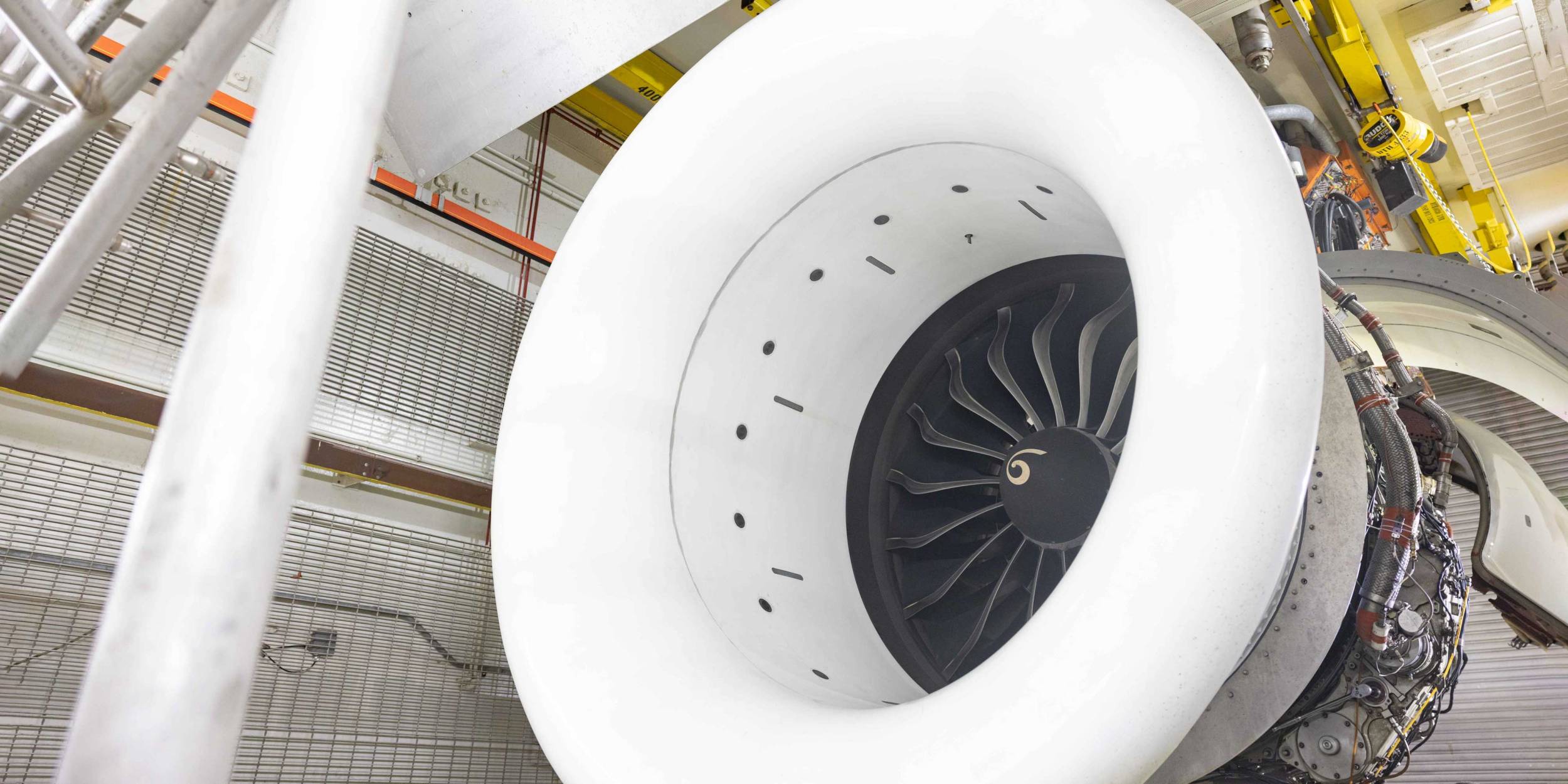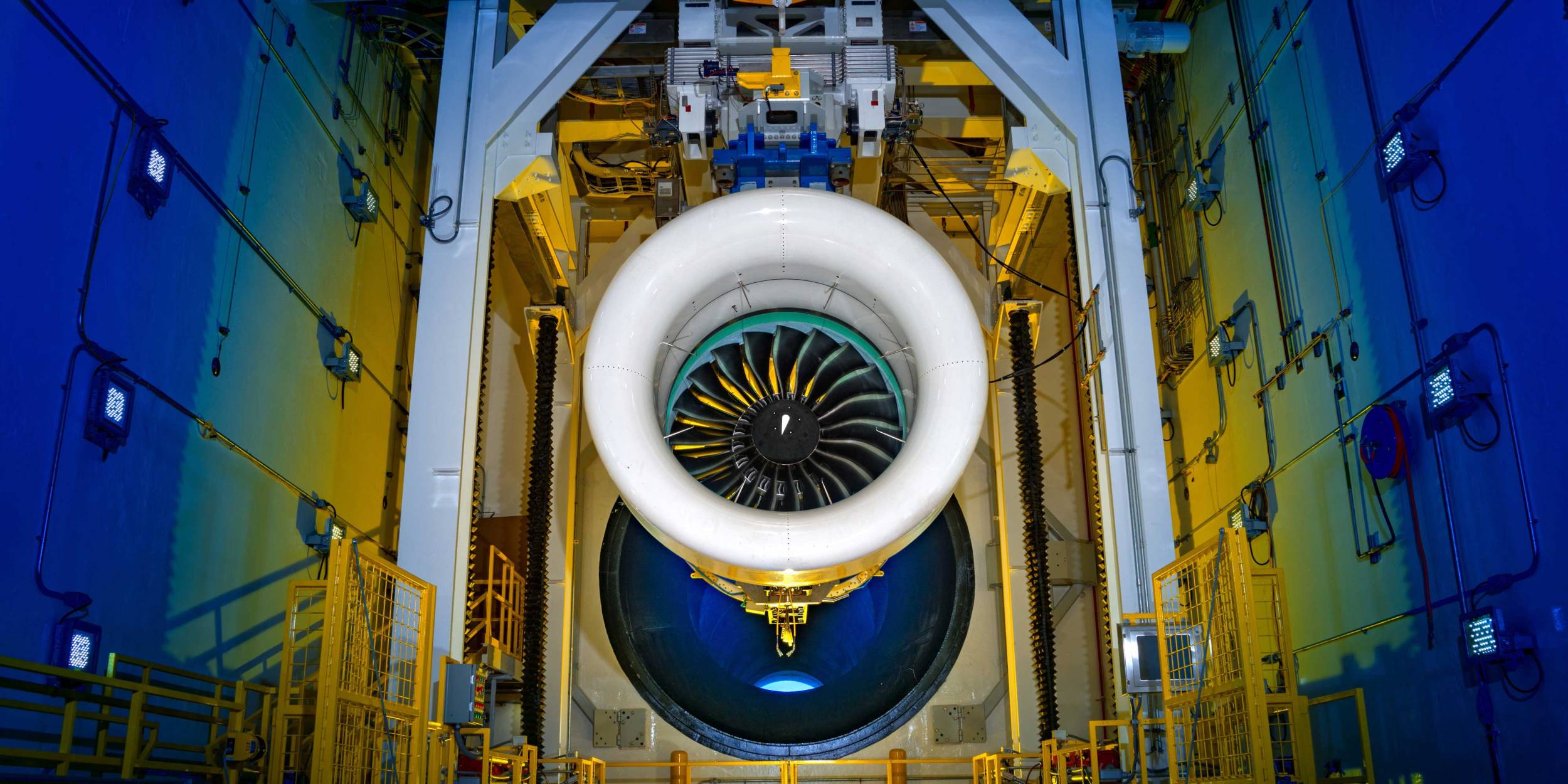Click Here to View This Page on Production Frontend
Click Here to Export Node Content
Click Here to View Printer-Friendly Version (Raw Backend)
Note: front-end display has links to styled print versions.
Content Node ID: 414264
With passenger traffic rebounding strongly as the Covid-19 pandemic recedes, Rolls-Royce, GE Aerospace, CFM International, and Pratt & Whitney have seen healthy sales of their commercial-engine families.
But even as they try to recover production to 2018 and 2019 levels while fighting to surmount long-term supply-chain disruptions involving materials and critical parts, all four stand committed to conducting research and development to ensure their product lines will meet the air transport industry’s 2050 zero-net carbon emissions target.

Rolls-Royce Takes Aim at 2035
Rolls-Royce remains strongly focused on the airline industry’s long-term future, from 2035 onward, when SAF, hydrogen propulsion, and electric power take part in achieving net-zero carbon performance, said Alan Newby, Rolls-Royce’s director of aerospace technology and future programs.
Newby told AIN that by the end of 2023 “virtually all” of Rolls-Royce’s range of Trent large turbofans will gain certification to operate commercially using 100 percent SAF as a fuel. But Rolls-Royce also believes “hydrogen will play a key part in de-carbonizing the world.”
Rolls-Royce’s research has indicated liquid hydrogen can replace SAF as a fuel for shorter-range operations by regional and even single-aisle jet aircraft, though long-range flights by large aircraft will continue to need jet-fuel power indefinitely. Even though liquid hydrogen weighs less than jet fuel, its much lower energy density requires much larger fuel tanks than those for any conventional fuel or pure SAF.
Additionally, said Newby, the minus-253-degree C temperature required to keep hydrogen in liquid form, plus the need to heat it to a room-temperature gas for combustion, will make the onboard heat-management and pumping infrastructure for liquid-hydrogen fuel complex and heavy.
In one of several hydrogen-propulsion R&D programs in which it is involved, Rolls-Royce and 25 partners have established a rig at Cranfield Airport to test integration of an onboard hydrogen fuel-provision system with an engine and nacelle. The many areas of testing the rig will conduct include the design’s fire-management and hydrogen fuel-drainage capabilities.
Newby said that, in other hydrogen-propulsion research in which the engine maker partners with German aerospace institute DLR, Rolls-Royce Deutschland is designing fuel-injector architectures for testing on a rig DLR has developed to test hydrogen fuel systems.
Meanwhile, under Project Napkin, a program in which Rolls-Royce partners with EasyJet, testing last November at Boscombe Down in the UK saw the company run an AE 2100 turboprop powerplant—the engine powering the Lockheed C-130—using green hydrogen as fuel.
“We only needed to change its fuel injectors” to perform the ground run successfully, said Newby. “We’re even driving emissions testing [of the hydrogen-powered AE 2100 testbed] – there is work needed to optimize it to minimize NOx emissions.”
Meanwhile, Rolls-Royce continues to develop its geared-turbofan UltraFan architecture; the company announced on May 18 that it had successfully completed the first ground runs of its 140-inch-fan UltraFan demonstrator powered by 100 percent SAF.
Rolls-Royce’s future UltraFan testing will include the use of hydrogen fuel and “more electric” propulsion architectures, said Newby. The tests include the use of “micro-hybridization,” in which relatively small amounts of electrical power will boost each jet-fueled gas-turbine engine “to enhance its performance throughout the entire flight envelope.”
The many hydrogen-propulsion R&D projects in which Rolls-Royce is involved will culminate with ground-testing a Pearl 15 turbofan modified to use “green” hydrogen as fuel. Rolls-Royce—in partnership with EasyJet—will subsequently begin flight-testing the engine.
“Rolls-Royce will put a technology program in place in time to start production [of hydrogen-fueled engines]…for when the manufacturers want the engines for their aircraft,” said Newby. “Given that we need lead time for a production program, we will need to have the mature technology ready for the back end of this decade.”

CFM Rides Leap to New Sales Heights
CFM International, the 50-50 partnership between GE Aerospace and Safran Aircraft Engines, has accumulated orders and other commitments for some 21,000 Leap engines, making it the fastest-selling jet-engine family in history, according to Gaël Méheust, CFM’s president and CEO.
Méheust noted that the Leap-family engines had accumulated more than 30 million flight hours by mid-May, achieving a 92.5 percent utilization rate. The highest-time engines have already recorded 10,000 flight cycles and 18,000 flight-hours on wing since entering service only seven years ago.
The Leap family is demonstrating in-service fuel-efficiency improvements in the 15 to 20 percent range over its direct predecessors, primarily the CFM56 family, Méheust said.
CFM has experienced a durability issue with Leap-1A and Leap-1B engines flown by airlines primarily operating in hot and harsh conditions, particularly in the Middle East. The durability problem resulted from a combination of hot external temperatures and ingested sand, causing premature wear in Leap high-pressure turbine (HPT) nozzles and high-pressure turbine blades.
To find a permanent fix, said Méheust, the manufacturer built a unique ground-testing rig that duplicates the exact sand-ingestion and external-temperature conditions that led to the durability issues. Rig-testing of the relevant HPT parts saw the parts experiencing the same problems in-service engines experienced.
However, when tested in the rig, newly redesigned HPT nozzles and blades did not display the wear. “So we know the fix will work and we are confident it will be successful,” said Méheust. “It is now a matter of a little bit of time before the Leap behaves like the [ultra-reliable] CFM56 in the Middle East.”
Meanwhile, the CFM56 remains the world’s best-selling jet engine. The company has delivered some 34,000 of the engines and the family has recorded more than 1.2 billion flight hours in service. The CFM56-7B powering the Boeing 737NG family accounts for 500 million hours of the total.
Some 22,000- to 23,000 CFM56s remain in service and the CFM56 family accumulates one million additional flight hours every week and continues to average 99.98 percent dispatch reliability.
GE Aerospace’s GEnx Dominates Class
Although volume production of the GEnx-2B large turbofan powering the Boeing 747-8 has finished, GE Aerospace continues to see strong demand for the GEnx-1B powering the Boeing 787, according to Kathy MacKenzie, president and CEO of GE Aerospace’s commercial engine operations.
Some 2,400 GEnx engines have entered service and GE holds orders for 520 more, almost all of them GEnx-1Bs. With the competing Rolls-Royce Trent 1000 family having experienced groundings related to production errors some years ago, the GEnx-1B now dominates the market. “We have hundreds of [sales] campaign opportunities,” MacKenzie told AIN.
MacKenzie said GE Aerospace plans not to introduce another major GEnx upgrade package for the next two years. “We will be trying to advance our next suite of technologies [during that period]” developed from GE’s participation in CFM’s massive Rise R&D program. “We’ll evaluate bringing those improvements back into our existing engines,” she added.
Meanwhile, said MacKenzie, orders—and new MRO shop visits—for GE Aerospace’s legacy CF6-80 large turbofan continue to grow. The CF6-80 powers the Boeing 767-300F production freighter, orders for which remain robust.
Sales also remain healthy for the GE90-110B large turbofan, which powers the Boeing 777F production freighter. GE90-family sales to date number more than 3,000. MacKenzie said GE Aerospace also continues to see strong new-order demand for its mid-sized CF34 turbofan family, members of which power the strong-selling Embraer 175 and Comac ARJ21 regional jets.
Separately, GE Aerospace temporarily halted the Boeing 777X flight-test program in 2022 when, during maturation and validation testing at its Peebles, Ohio ground-test facility, it found a hot-section part did not demonstrate the expected performance response, according to MacKenzie.
However, she said, GE quickly created a design improvement incorporated in all test GE9Xs, and the affected engine returned to flight test within 10 weeks. GE Aerospace is now “trying to line up the improvement” for incorporation in all production GE9Xs.
RISE Program Eyes Giant Efficiency Leap
GE Aerospace and CFM remain highly focused on the CFM-led Rise R&D program, which Méheust described as “the most comprehensive technology acquisition and maturation program in CFM’s history.”
CFM’s two joint venture partners have dedicated more than 1,000 engineers to the Rise program. According to Méheust, the companies have seen Rise make “good progress” through early technology maturation. “We’re moving from part and component testing to begin testing sub-systems,” said Méheust. “We’re on track to ground-test a demonstration open fan [engine] somewhere in 2026-2027.”
Later testing of Rise demonstrators will test 100 percent SAF and hydrogen as fuels for the open fan configuration, and for any other engine configuration, CFM decides to explore within Rise. “SAF is a no-brainer,” said Méheust. “One hundred percent SAF has already been tested successfully in the Leap-1B.”
CFM’s Rise hydrogen-fuel testing will build on the joint venture's partnership with Airbus to flight-test on an A380 a rear fuselage-mounted GE Passport engine modified by CFM to use hydrogen fuel. Airbus will provide the tank storage and the system supplying the hydrogen to the engine.

Pratt & Whitney Tackles Hybrid, Hydrogen Power
Together with sibling Collins Aerospace, Pratt & Whitney (P&W) is developing a hybrid-electric and gas turbine-powered propulsion system. The demonstrator engine completed its first ground run in Québec in December and the partners plan to begin flight testing the system in 2024.
In parallel, under a U.S. Department of Energy contract, P&W has begun developing the Hydrogen Steam Injected, Intercooled Turbine Engine (HySIITE). That powerplant will use liquid hydrogen combustion and water-vapor recovery to achieve zero in-flight CO2 emissions in future single-aisle aircraft, while reducing NOx emissions by up to 80 percent and fuel consumption by up to 35 percent.
P&W’s GTF family has accumulated 21 million flight hours and has won orders and commitments for more than 10,000 engines.
“We’ve now met the target level for dispatch reliability, which is at mature levels,” said Dave Emmerling, P&W’s v-p of GTF Engines. “We’ve improved time on-wing since the beginning of the program, and we continue to do so with block upgrades in process on all our GTF variants and the GTF Advantage program.”
The GTF Advantage—a major upgrade on the PW1100G powering the A320neo family—has accumulated 2,800 hours and 8,200 cycles of ground and flight testing into its validation program over two years. Meant to achieve a 1 percent efficiency gain over the current PW1100G, the Advantage program includes extensive endurance testing to provide mature reliability at entry into service, said Emmerling. “The test program is designed with special attention to severe-environment operations. This includes hot-section endurance, rapid cyclic accumulation, and dirt ingestion.”
That will prove important because many GTFs—particularly those operated primarily in hot and harsh environments—have experienced takeoff-weight-reducing durability issues and severe supply chain-driven shortages of spare parts. The problems have grounded many GTF-powered aircraft operated by various airlines, and in April led to Indian A320 operator Go First filing for bankruptcy and suing P&W for $1 billion.
P&W’s remedial actions include “incorporating durability upgrades to increase time between engine removals, especially in hot and harsh environments,” said Emmerling. “We’ve been introducing more durable combustor hardware to our customers. Today, more than 50 percent of the GTF-powered A320neo family has the latest upgrade, and we anticipate most of the fleet will have it in the next couple of years.”